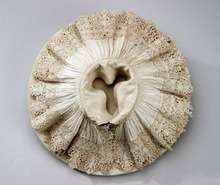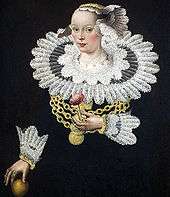Ruff (clothing)

A ruff is an item of clothing worn in Western Europe from the mid-sixteenth century to the mid-seventeenth century.

Description
The ruff, which was worn by men, women and children, evolved from the small fabric ruffle at the drawstring neck of the shirt or chemise. They served as changeable pieces of cloth that could themselves be laundered separately while keeping the wearer's doublet from becoming soiled at the neckline.
History

"Ten yards is enough for the ruffs of the neck and hand" for a New Year's gift made by her ladies for Queen Elizabeth in 1565,[1] but the discovery of starch allowed ruffs to be made wider without losing their shape. Later ruffs were separate garments that could be washed, starched, and set into elaborate figure-of-eight folds by the use of heated cone-shaped goffering irons. Ruffs were often coloured during starching, vegetable dyes were used to give the ruff a yellow, pink or mauve tint.[2] A pale blue colour could also be obtained via the use of smalt, although Elizabeth I took against this colour and issued a Royal Prerogative:
| “ | Her Majesty's pleasure is that no blue starch shall be used or worn by any of her Majesty's subjects, since blue was the color of the flag of Scotland ...[3] | ” |
At their most extreme, ruffs were a foot or more wide; these cartwheel ruffs required a wire frame called a supportasse or underpropper to hold them at the fashionable angle. Ruffs could make it difficult to eat during mealtimes, similar to the cangue.[4] By the end of the sixteenth century, ruffs were falling out of fashion in Western Europe, in favour of wing collars and falling bands. The fashion lingered longer in the Dutch Republic, where ruffs can be seen in portraits well into the seventeenth century, and farther east. It also stayed on as part of the ceremonial dress of city councillors (Senatoren) in North German Hanseatic cities and of Lutheran clergy in those cities and in Denmark, Norway, the Faroe Islands, Iceland and in Greenland.
The ruff was banned in Spain under Philip IV (orchestrated by Gaspar de Guzmán, Count-Duke of Olivares).[5]
Today

Ruffs remain part of the formal attire of bishops and ministers in the Church of Denmark and are generally worn for services. They were abolished by the Church of Norway in 1980, although some conservative ministers such as Børre Knudsen continued to wear them. Ruffs are optional for trebles in Anglican church choirs.[6] Underground artist Klaus Nomi used a ruff as part of his concert attire toward the end of his life, both as a complement to the renaissance-era music he began focusing on in this time frame and to hide the effects of Kaposi's sarcoma. In the twentieth century, the ruff inspired the name of the Elizabethan collar for animals.
Gallery
.jpg) 16th century ladies ruffled collars (ruffs)
16th century ladies ruffled collars (ruffs)_-_WGA24408.jpg) Philip III of Spain ca. 1615. Detail from a portrait by Velázquez
Philip III of Spain ca. 1615. Detail from a portrait by Velázquez Robert Orpwood (d. 1609, painted ca. 1615)
Robert Orpwood (d. 1609, painted ca. 1615) The wife of the burgomaster of Lübeck, 1642
The wife of the burgomaster of Lübeck, 1642 Emperor Pedro II of Brazil, ca. 1872
Emperor Pedro II of Brazil, ca. 1872 Members of an English school choir wearing ruff collars, ca. 1960
Members of an English school choir wearing ruff collars, ca. 1960 The ruff as worn by Danish bishop Erik Normann Svendsen, ca. 1999
The ruff as worn by Danish bishop Erik Normann Svendsen, ca. 1999 Church of England choirboys wearing ruffs in 2008
Church of England choirboys wearing ruffs in 2008
References
- ↑ Mary S. Lovell, Bess of Hardwick, Empire Builder 2005:184.
- ↑ Picard, Liza. Elizabeth's London (2003)
- ↑ Forbes, T.R. Chronicle from Aldgate (1971)
- ↑ Westman, Hab'k O. (1844). Transactions of the Society of Literary & Scientific Chiffoniers. New York: Harper & Brothers. p. 58. Retrieved 6 February 2016.
- ↑ Pennington, D. H. (1989). Europe in the Seventeenth Century (2nd ed.). Harlow: Pearson. p. 382. ISBN 0-582-49388-9.
- ↑ Wenlock Chalice and Paten set. "croftdesignshop". croftdesignshop. Retrieved 2012-08-24.
Bibliography
- Janet Arnold: Queen Elizabeth's Wardrobe Unlock'd, W. S. Maney and Son Ltd., Leeds 1988. (ISBN 0-901286-20-6)
External links
| Wikimedia Commons has media related to ruffs. |
- How To Starch a Ruff Part I of IV
- Portraiture illustrating development from modest 1530s ruffs to the gigantic ruffs of the 1590s
- 17th century millstone ruff at the Rijksmuseum in Amsterdam